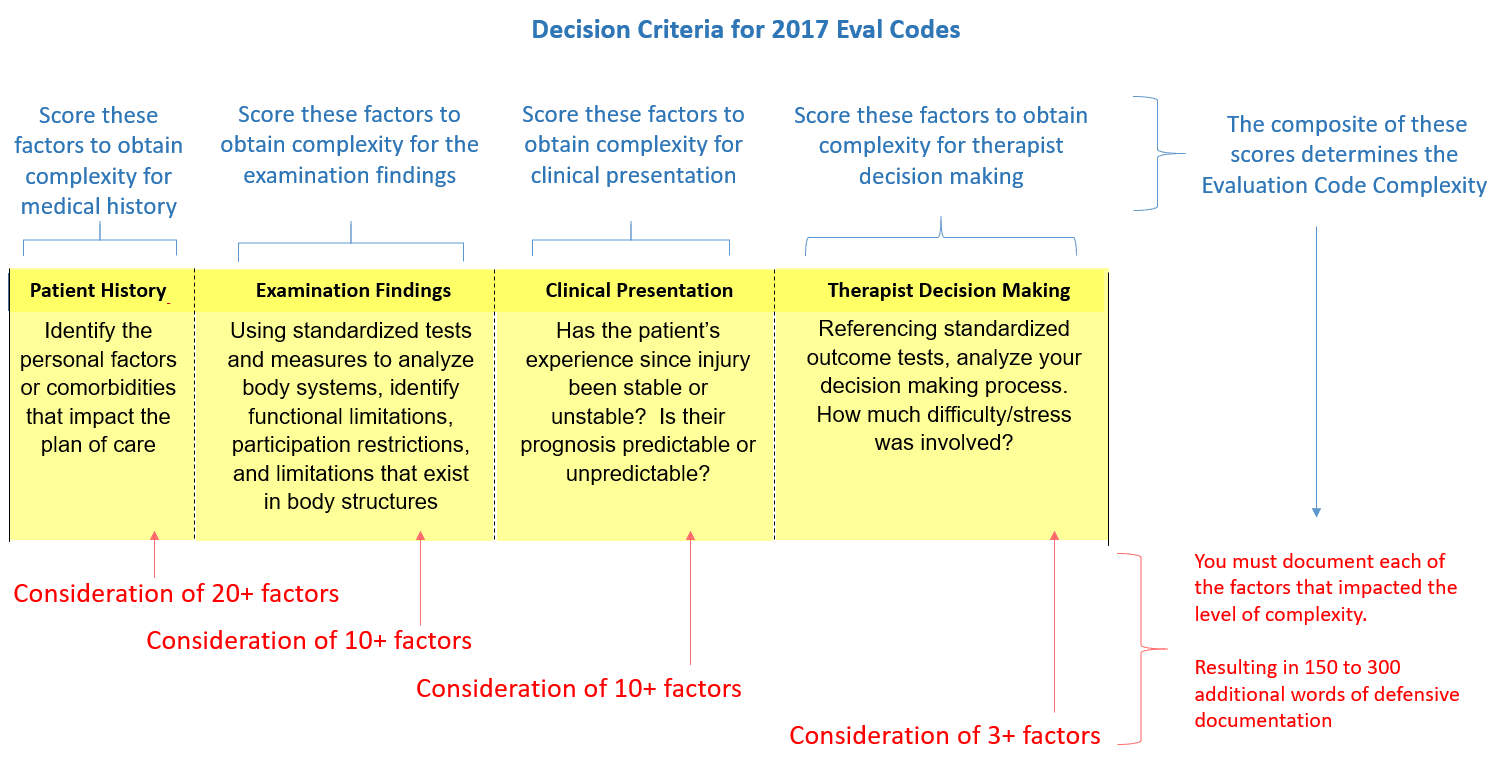The Important Medicare Compliance Requirement
That’s Often Overlooked
Everyone is concerned about Medicare compliance, and for good reason: Medicare audits are conducted by commission-based subcontractors. These companies are only paid if they find compliance shortfalls, which they’re very good at doing.
But since January 1, 2017, many practices have been writing underdefended, non-compliant Medicare evaluations.
January 1, 2017 was when the CMS launched the complexity-specific evaluation codes that we use today:
97161 – 97163 for P.T. and 97165 – 97167 for O.T.
In 2016, the CMS provided a standardized workflow to determine and defend whether the eval code should be “Low,” “Moderate,” or “High” complexity. That workflow is shown below. The red text is the defensive documentation required by Medicare in every evaluation.

Accurately reporting complexity is important. Because G-codes are no longer reported, Medicare has no idea if the patient’s severity is 10% or 90%. And in 2020, outpatient rehab will be included in Medicare’s “Cost” component, as Medicare will compare the number of visits for your patients (their cost), vs. average. Obviously, higher-complexity patients often require a greater number of visits vs. than do low complexity patients. It is more important than ever that your evaluation defends the eval code complexity precisely as the CMS instructs.
What Does This Defensive Documentation Look Like?
Here is an example of compliant eval code defense:
Complexities related to the patient’s history that impact the plan of care include: The patient is 82 years old, which is expected to increase recovery duration. The patient’s previous functional level for walking normal distances was 7/10, which limits recovery potential. Climbing stairs aggravate symptoms. The patient’s home has stairs. The patient lives alone. The patient does not regularly exercise and demonstrates low tone, strength, and endurance. Prior hip joint replacement in 2012. The patient demonstrates fear avoidance which limits the speed of recovery. The patient exhibits a self-limiting approach to activities, which slows progression. The patient’s language skills are limited, which complicates communication. During the examination, the following complexities, which impact the plan of care, were discovered: BMI score of 32.08. The patient’s diabetes is not under control. Faber Test, positive: Indicating sacroiliac joint dysfunction. Thomas Test, positive: Indicating tightness of primary hip flexor muscles, limiting L.E. extension. AROM is 31% vs. normal.
Strength is 18% vs. normal. Functional limitations that impact the plan of care: Difficulty dressing, lifting heavy weights from the floor, walking normal distances, Sleeping, Employment/homemaking tasks. The patient’s clinical presentation is high/unpredictable. Increasing pain, fluctuating between 4/10 – 8/10 today vs 6/10 at the onset. Progression is expected to be unstable and unpredictable. Oswestry Disability Index score: 88. Optimal Disability Index score: 76. The patient’s diagnosis is highly complex: 97163.
Systems 4PTs technology recommends this defensive documentation in the blink of an eye.
With your EMR, IF you want to be Medicare compliant:
- You’ll spend 3-5 minutes completing the eval code workflow and scoring (shown above)
- And then document 150-300 words to defend each complexity-related topic in the “Eval Code Defense” section of the evaluation
- For every Medicare patient
There’s no wiggle room here. Medicare is crystal clear about the necessity for this defensive documentation.
Eval code defense is one of dozens of examples how Systems 4PT delivers compliance at a completely higher level than any other EMR.
Here is how Systems 4PT enables you to document a compliant, well-defended Medicare evaluation:
Systems 4PTs Technology:
- Data mines the evaluation and populates complexity topics in each of the four appropriate categories per the CMS workflow
- Auto scores each category per CMS rules
- Displays the defensible evaluation complexity code
This happens in a nanosecond.
- The therapist then adds their clinical judgment
- Each category is rescored per therapist edits
- The updated, defensible eval complexity code is recommended
Upon therapist approval,
- The defensible eval code is added to the treatment plan
- The CMS-required defended documentation is recommended in the evaluation (shown to the right)
- The therapist reviews and edits as appropriate
The entire process takes about 20 seconds.
Today, your Medicare evaluations do not comply with CMS mandated eval-complexity defense. This leaves you vulnerable to an expensive commission-based audit.

Complexities related to the patient’s history that impact the plan of care include: The patient is 82 years old, which is expected to increase recovery duration. The patient’s previous functional level for walking normal distances was 7/10, which limits recovery potential. Climbing stairs aggravate symptoms. The patient’s home has stairs. The patient lives alone. The patient does not regularly exercise and demonstrates low tone, strength, and endurance. Prior hip joint replacement in 2012. The patient demonstrates fear avoidance which limits the speed of recovery. The patient exhibits a self-limiting approach to activities, which slows progression. The patient’s language skills are limited, which complicates communication. During the examination, the following complexities, which impact the plan of care, were discovered: BMI score of 32.08. The patient’s diabetes is not under control. Faber Test, positive: Indicating sacroiliac joint dysfunction. Thomas Test, positive: Indicating tightness of primary hip flexor muscles, limiting L.E. extension. AROM is 31% vs. normal.
Strength is 18% vs. normal. Functional limitations that impact the plan of care: Difficulty dressing, lifting heavy weights from the floor, walking normal distances, Sleeping, Employment/homemaking tasks. The patient’s clinical presentation is high/unpredictable. Increasing pain, fluctuating between 4/10 – 8/10 today vs 6/10 at the onset. Progression is expected to be unstable and unpredictable. Oswestry Disability Index score: 88. Optimal Disability Index score: 76. The patient’s diagnosis is highly complex: 97163.
Determining and defending eval code complexity is one of dozens of examples of how Systems 4PTs technology is at an entirely higher level than any other EMR.
- Our Medicare-compliant evaluations are documented in half the time vs. any other EMR
- With most Systems 4PT daily notes, when the daily visit is over, the note is signed
- Systems 4PT has demonstrated the highest MIPS scoring in the industry
- With a 20-second MIPS workflow
- Systems 4PT delivers the cleanest claims in the industry, with a 99.87% first-pass acceptance rate
- Systems 4PT reports PROFIT, by referral source, by payer, and by therapist/PTA/COTA
Provided for 1/3 less than you spend today for EMR and billing.




